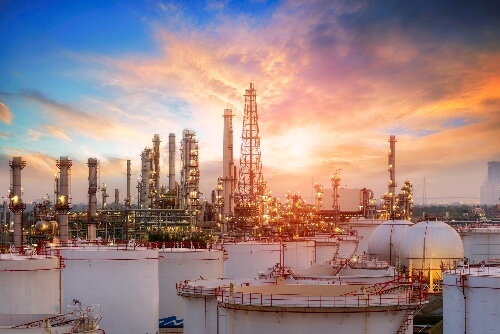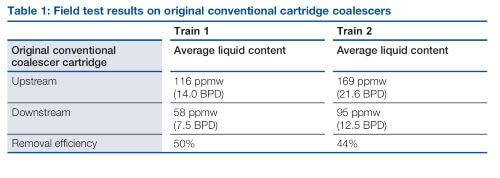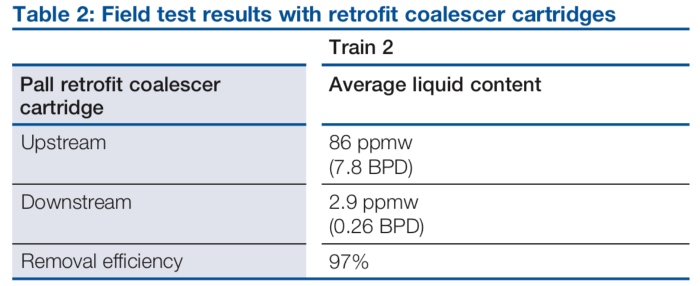Oil & Gas: Application Focus
Pall Coalescer retrofit generates over $300,000 yearly savings in amine
Background
A Middle East gas processing plant operates two parallel trains, each train has an acid gas removal unit (AGRU), and it processes about 400 MMSCFD at 72 barg. In the AGRU, the absorber is protected by 3 x 33% 44 inch diameter vertical cartridge coalescers; each housing holds 48 conventional fiber glass coalescer cartridges. The original process specifications required a liquid and solid removal efficiency of 99.98% at 0.3 micron and larger.
Efficient elimination of liquids and solids from the feed gas is critical to avoid foaming incidents and other operational problems in the AGRU. Vertical liquid/gas cartridge coalescers are commonly seen as having better liquid removal capabilities compared with horizontal filter-separators, mesh pads, cyclones, or vane packs. However, a vertical configuration for a cartridge coalescer is not enough to avoid liquid carry-over, and conventional cartridge coalescers are no exception. In fact, the features of the coalescer cartridge, namely its chemical surface treatment that enhances the coalesced liquids to drain faster, are essential to achieve minimal liquid content at the coalescer outlet.
What causes foaming in amine contactors?
The plant experienced foaming incidents in both trains, which forced them to inject anti-foam continuously. As part of their troubleshooting campaign, liquid carry-over from the feed gas separator was suspected, despite the assumed high-performance specifications. This was highly probable, since the existing cartridges did not feature any surface treatment. Liquid-carry over was investigated with the support of Pall Corporation, by connecting coalescer test units on a slipstream to the main line, at the inlet and at the outlet of the feed gas separator. Results are shown in Table 1. Testing revealed that the liquid removal performance was about 50% only at best in both trains. This resulted in outlet liquid contents of 58 ppmw and 95 ppmw on average.
It was obvious that the cartridge’s features would not enable an improvement of the separation performance.
Pall Solution
New high-efficiency liquid/gas coalescer cartridges with the same dimensions and adaption style were designed and manufactured by Pall Corporation, to fit instead of the existing conventional cartridges. To improve the coalescing and drainage of liquids, the Retrofit coalescers used the same full element oleophobic and hydrophobic, fluoropolymer-based surface treatment features used in the standard SepraSolTM Plus coalescers.
A set was installed in train 2 for a full-scale trial. A performance test was conducted using the same coalescer test unit. Results are shown in Table 2. The retrofitted coalescer achieved significantly lower outlet liquid content, 2.9 ppmw.
Benefits
Due to the significant reduction in liquid ingression into the absorber, the plant was able to gradually reduce their anti- foam consumption, from continuous down to three injections per day and an overall consumption of 0.38 barrels per day. This represented a 75% drop in anti-foam consumption, and assumed projected savings greater than $300,000 per year for one train, assuming a cost of $5 per liter. Additional savings relating to more stable production, reduced change- out frequency of the solvent filter, and the carbon bed are being quantified.
Overall this retrofit solution turned to be very cost-effective, as it required no Capex, only the purchase of the coalescer cartridges and the new holding plate, funded from the maintenance budget. Overall the spending for the plant was $35,000 for one train. Looking at savings on anti-foam consumption only, the payback is about two months, assuming a yearly cartridge replacement.
The plant was very satisfied with the results and duplicated the feed gas separator upgrade on the other train.
Conclusion
High-efficiency liquid/gas coalescers feature a full element fluoropolymer-based surface treatment that enhances their liquid drainage capability. This results in the minimum liquid left in the outlet gas. This surface treatment is proven to make a significant difference in the field, compared with conventional non- surface treated cartridge coalescers.






